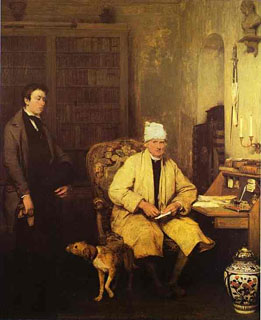David Wilkie left his native Scotland for London in 1805, when he was nineteen years old, and went on to become one of the most successful and sought-after British painters of the nineteenth century – so much so that at the Royal Academy’s annual exhibitions at Somerset House his pictures had to be roped off, such was the crush of spectators which they regularly attracted. Wilkie has not exactly sunk into obscurity, but he is far less famous than he once was. On the eve of the first extensive survey of his work for more than 40 years, at the Dulwich Picture Gallery, this week’s painting is his Letter of Introduction.
Wilkie made his name as a painter of populous genre pictures in which groups of down-at-heel but cheerful Scottish country folk are shown playing cards, getting married, listening to music or engaging in heated political debate. The picture shown here inaugurated a group of quieter works inspired by the world of the middling to upper orders of English society. “Their stories are not bustling; their figures are but few; for these reasons they may not be so popular with the million,” pronounced the critic of The Champion. He was wrong. When The Letter of Introduction was unveiled to the general public in 1814, it turned out to be Wilkie’s most popular production yet.
The painting tells the story of an awkward first encounter. A young man has come to call on a considerably older gentleman, who receives him in the sanctuary of his study. To justify his intrusion, the young man has brought with him the “letter of introduction” of the painting’s title: a reference written by a mutual acquaintance indicating, no doubt, that the young fellow is of good character, and probably hinting too at the...


